Modern cosmetics allow you to effectively care for your skin at any age, so when subcutaneous pimples appear on your forehead, it becomes an annoying surprise. It is not always possible to solve this problem quickly. Usually you have to treat the skin for several days. It is important not to injure the skin in the hope of mechanical removal of the contents, but to perform certain sequential actions to restore health.
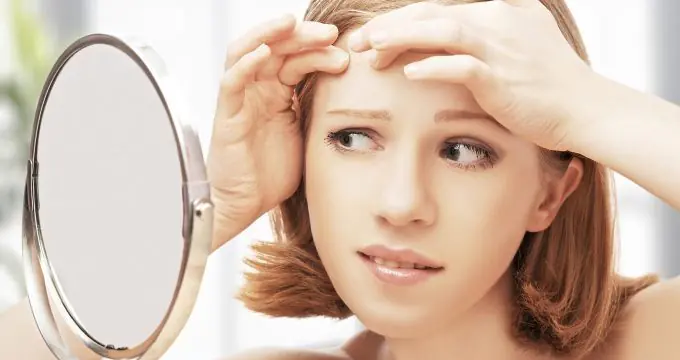
How do subcutaneous acne appear on the forehead?
The appearance of acne is one of the most unpleasant skin inflammations. They can develop for many reasons, take a long time to heal, and cause pain. Against the background of developing inflammation, purulent accumulations form under the skin, and a significant tubercle appears. When pressed, the pain and redness intensify.
The mechanism of formation is the mixing of sebum with dust and the accumulation of this substance at the mouths of the glands. Such an environment promotes the proliferation of harmful microorganisms and the formation of a focus of infection. It is the basis for the formation of pimple or acne vulgaris. Essentially, this is a blockage of the sebaceous gland ducts. The resulting plugs make the problem worse because they are difficult to remove. Depending on several factors, acne varies in size, degree of inflammation, and duration of treatment. If removed unprofessionally, the process may take up to 2-3 weeks and may result in scars or scars.
Reasons for education
Before treatment, possible causes are determined. Usually these are microbes or hyperactivity of the sebaceous glands. They manifest themselves individually in everyone, depending on skin type, age, and cosmetics used. The main factors causing acne on the forehead:
- Metabolic disorders, unhealthy diet;
- The effect of certain medications;
- Problems with the gastrointestinal tract, liver, pancreas;
- Adolescence;
- Changes in hormonal levels;
- Irregular facial skin care;
- Constant irritation with hair, in the presence of bangs;
- Poor quality cosmetics;
- Sedentary lifestyle.
Squeezing is not the best way because it can lead to even more inflammation and swelling. Pimples on the forehead bother both women and men. A timely visit to a dermatologist or cosmetologist helps solve the problem. Modern research and treatment methods can alleviate the suffering of patients and quickly relieve diseases.
Treatment
The main condition for successful treatment is a comprehensive effect on the cause of inflammation. The action of the drugs is based on eliminating microbes, reducing inflammation, reducing the activity of the sebaceous glands, and astringent properties.
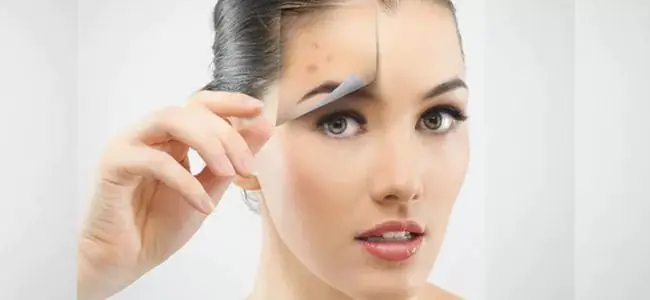
Medicines
Zenerite. It is characterized by antimicrobial, anti-inflammatory and comedolytic effects. Fights acne that is resistant to cosmetic and hygiene products. Contains erythromycin and zinc. Universal packaging allows you to conveniently store and use the solution.
Baziron AS. It comes in the form of a gel and can have different concentrations. The highest is chosen for severe cases of skin damage. The drug fights inflammation, saturates cells with oxygen, reduces the formation of sebum, and adsorbs existing deposits.
Skinoren. Creamy or gel consistency is convenient for application to individual areas of the skin. The main component, azelaic acid, actively fights bacteria. Since the product is also intended to combat hyperpigmentation, it protects the skin from UV.
Erythromycin ointment. The active substance blocks the synthesis of proteins at the cellular level of microorganisms and stops their spread. It is one of the oldest antibiotics and is used even in the presence of allergies. May be prescribed in the form of ointment or tablets.
Differin. The main substance is adapalene. Targeted at eliminating acne. Apply to affected areas before bedtime. It can be used as a monotherapeutic agent or in combination with local or systemic drugs. Well tolerated by dry and sensitive skin.
What do beauty salons offer?
Mechanical cleaning is performed by a cosmetologist using special devices and antibacterial agents. This procedure is possible only at a certain degree of maturation of the pimple.
The result of ozone therapy is the relief of pain and redness. Reduces the risk of residual effects in the form of scars. Promotes the production of collagen and elastin necessary for cell regeneration.
Elos technology is based on pulsed blue light. It soothes the skin, tightens pores, accelerates healing and restoration of damaged tissue. Also a procedure without side effects melsmon.
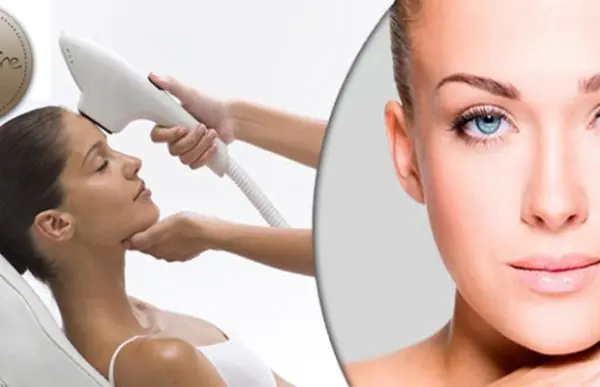
Caring for problem skin at home
Diagnostics and appropriate therapy can be combined with the use of traditional methods at home. It is important to maintain regularity of procedures. Popular methods to solve the problem:
- Lotions based on decoctions of medicinal plants. Mint, string, sage, calendula, horsetail, chamomile, celandine, and oak bark have anti-inflammatory properties. Usually the infusion is cooled, filtered and used for washing, lotions, and rubbing;
- Solutions using lemon juice. Add a few drops of lemon juice to a glass of cooled boiled water. Wipe the face 2 times a day;
- Salt concentrates. Dissolve 2 tablespoons of salt in a glass of warm water. Used as applications, compresses on problem areas;
- Ichthyol or Vishnevsky ointment. These compounds have the property of drawing out purulent contents. For targeted treatment, a small amount is applied to a gauze pad and secured with a bandage or bandage. The specific odor is compensated by effective pore cleansing;
- Steam baths. It is recommended to first discuss with your doctor the possibility of applying heat to the affected skin. Steam expands and cleanses pores well. The use of medicinal herbs helps to carry out anti-inflammatory and antibacterial therapy for the deeper layers of the epidermis;
- Masks. It is recommended to alternate formulations with different effects. For example, an oatmeal mask soothes and softens the skin. A mask with aloe juice is an excellent antiseptic.
As a regular care product, many cosmetic companies offer products based on tea tree and aloe. A variety of creams, serums, powders, and lotions help control the development of inflammation throughout the day. Specific receptors help avoid exposure to the external environment and cosmetics.
Periodic visits to the doctor help you understand how to get rid of subcutaneous acne on the forehead. Streamlining your daily routine, giving up bad habits, and preventing colds help maintain immunity and resist inflammation.
It is also important to review your diet and reduce the consumption of fatty, sweet, fried foods, white bread, processed foods, and carbonated drinks. Healthy skin requires long sleep, a balanced diet, exercise, preventive examinations, proper care and high-quality cosmetics. All this allows you to treat subcutaneous acne on the forehead and prevent the appearance of skin problems, including wen.
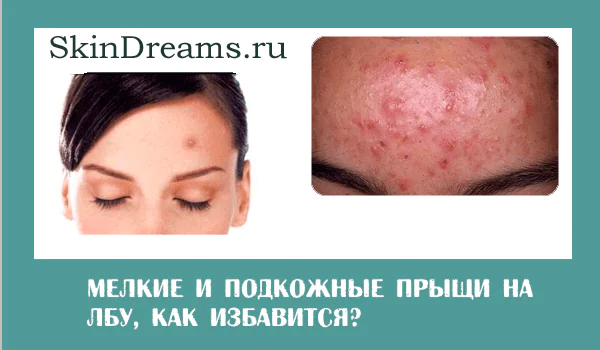
I already discussed this on my blog problemswith acne on the forehead. But today I would like to touch on the topic of small and subcutaneous acne on the forehead, especially subcutaneous ones, since it is their appearance that creates a lot of problems on your lovely skin.
Every person wants to have excellent facial skin, and when will the forehead be covered with “subcutaneous pads”? That looks This is terrible, especially girls who have a complex, because you can’t create cool hairstyles with an open forehead. And we guys like it when girls look 100% ;)
Therefore, I will try to analyze the topic of internal, subcutaneous acne on the forehead, and of course, let’s not forget about small pimples, because any problem starts small, and only then grows into serious problems.
Small and subcutaneous pimples on the forehead causes
I want to start with subcutaneous acne, because having defeated them, then all other acne will seem like the easiest problems to you.
Causes:
Subcutaneous acne appears for the same reasons as other acne. There are only four reasons:
I discussed all these reasons in detail in this article, and in this note I will tell you briefly.
- Testosterone hormone.
- Excess sebum. During adolescence, testosterone increases the production of sebum.
- Clogged pores. Due to the fact that there is a lot of fat, pores become clogged more quickly.
- Bacteria. It is the bacteria that get under the pores that create inflammation and those terrible, painful pimples appear.
«Subcutaneous“This is a special “caste”, if small pimples can disappear on their own, then internal pimples will not disappear so easily. This occurs due to a strong accumulation of sebum in the sebaceous gland. When there is a lot of nutrient medium, bacteria multiply faster and on a larger scale.
Such a large accumulation in the glands does not just happen. There are several reasons that provoke internal acne:
- Hormonal imbalances. I think the dependence here is clear, the more androgens in the blood, the more sebum is produced, and the more nutritious environment for bacteria.
- Cold. The immune system is weakened, and therefore it becomes more difficult for our body to fight bacteria. Microbes take advantage of this and actively multiply.
- Disturbances in the digestive system. For this reason, the body does not receive enough vitamins.
- Nutrition with a lot of fatty and sweet. Improper nutrition aggravates acne, since excess fat is excreted through the skin, thereby accumulating a huge amount of sebum from the sebaceous glands, but think about the further scheme with bacteria getting into this explosive mixture, think for yourself :)
I would like to specifically note:
It has been noticed that different health problems have different effects on parts of the face, this dependence is called the acne map, you can read the detailed article at the link.
Problems with the liver and gastrointestinal tract aggravate the problem of acne on the forehead, this is especially noticeable when drinking large amounts of alcohol. Teenagers who are addicted to alcohol have much more skin problems than those who do not have such habits.
Treatment of subcutaneous acne
Subcutaneous:
In terms of treating “hypodermic ulcers” there are two points:
- Subcutaneous acne do not become inflamed quickly, therefore, as soon as pain and a small bump on the skin appear, you immediately need to use an antibacterial agent in order to kill bacteria and prevent inflammation from growing.
- If a subcutaneous pimple inflamed, then you must first pull the pus out, and only then use antiseptics. Since the pus is deep, antibacterial drugs will be ineffective.
As soon as I start to experience inflammation, I use chatter or sinerite. These products are antibiotic-based, so if you have other similar drugs in your arsenal, use them.
I told you how to make mash here. In terms of use, you need to remember a few rules
- Shake before use.
- If there is little acne, then apply accurately, slightly cauterizing the pimple.
- When there are a lot of pimples, wipe your entire forehead.
- If your skin is prone to dryness, then after applying the mash, use a moisturizer.
With zinerite The principle of use is the same. Which of these products to choose is up to you, but in my opinion, the talker looks more competitive, since the price is lower and the effectiveness is excellent. For example, at first I used zenerite, but when I found out about the talker, I immediately switched to it. This is my opinion, if you have your own ideas, write about them in the comments.
Inflamed subcutaneous acne.
When such acne becomes very inflamed, it is more difficult to fight it. Try not to go to extremes, but treat in the early stages.
If you are still inflamed, then you need modify the treatment regimen. To get started, use ichthyol ointment. This ointment will draw out the pus.
Apply ichthyol ointment to the pimple. After a few hours, the pus should come out, but if the pus remains under the skin film, it must be carefully squeezed out.
Squeezing out ripe pimples on the forehead is quite simple, remember the main thing.
- Disinfect your facial skin with any alcohol.
- Don't forget to sanitize your hands too.
- When the pimple is ripe, the pus comes out very easily, so you don’t need to press hard.
As a rule, the need to squeeze out occurs rarely, mostly pus comes out on his own.
Ichthyol has contraindications that can lead to undesirable consequences; my friend encountered them due to inexperience. Read a detailed article with my comments about ichthyol ointment here.
After the extrusion operation, use on this place antiseptic, the same chatterbox, or you can burn it with regular alcohol. It all depends on your preferences, as for me, two options are acceptable.
How to get rid of small pimples
Everything is very simple here. Small pimples do not go deep into the layers of the skin, because the inflammation is not severe, so treatment is quick and very simple.
The most effective are, of course, antibiotic-based drugs, I talked about them in chapter treatment of subcutaneous acne.
For example, wiping chatterboxth once a day on the acne area, after a week there will be no acne. Zinerite also shows the same result, I tried it all on myself :)
For prevention I recommend using white clay. The clay will cleanse the pores and remove the stratum corneum of the skin, thereby preventing the appearance of acne (for more details, see the article about clay).
Conclusion
If you develop subcutaneous acne on the forehead, it will be difficult and painful to treat. Therefore, as soon as pimples begin to appear, immediately use antibacterial drugs, thereby you will prevent bacteria from developing and a pimple will not appear.
Remember about preventionBy cleaning your pores, you will prevent the appearance of acne, and you will not have to get rid of them later.
I hope my article was useful to you, I look forward to your feedback. Share your experiences in treating acne.
Acne on the face or various parts of the body is often a consequence of internal disorders that arise due to errors in lifestyle, exposure to adverse factors or developing diseases. One of these problems is subcutaneous formations, which are not just an unpleasant aesthetic defect, but also a possible symptom of pathological processes occurring in the body.
What are subcutaneous acne
The process of formation of subcutaneous skin is directly related to the excessive production of sebum, which accumulates in the sebaceous ducts. It is a breeding ground for bacteria that multiply inside the sebaceous glands and provoke subcutaneous inflammation. As a result of the inflammatory process, a hard ball (bump) appears on the skin, which hurts when pressed and, unlike skin rashes such as pimples or acne, is not squeezed out in the usual way.
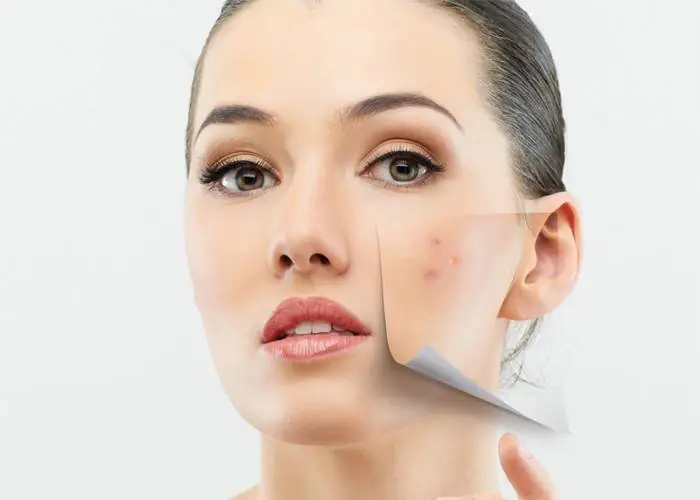
Inflammation affects the inner layers of the skin, and its superficial keratinized layer creates an obstacle to the normal cleaning of the sebaceous ducts. For this reason, it is difficult to get rid of subcutaneous acne, whether it is small white rashes or one large inflamed subcutaneous area. Such formations are located in the deep layers of the skin and “ripe” for a very long time, and therefore it is impossible to remove accumulations of sebum and pus from them using conventional methods.
Reasons for appearance
Having understood what subcutaneous acne is and what is the mechanism of its formation, it is necessary to find out what causes it. The main reason for the appearance of such rashes is a disruption in the process of sebum secretion, and it develops under the influence of a number of internal pathologies or external adverse influences. Why do subcutaneous lesions appear? Experts name the following factors that contribute to or provoke their formation:
- improper or insufficient skin care;
- hormonal imbalance associated with puberty, pregnancy, contraceptives, or endocrine diseases;
- overheating or hypothermia of the body;
- poor nutrition;
- abuse of peeling or tanning;
- disturbances in the gastrointestinal tract;
- reduced immunity;
- metabolic disease;
- hereditary predisposition;
- gynecological diseases;
- subcutaneous mite;
- bad habits (tobacco use, alcohol use).
On the face
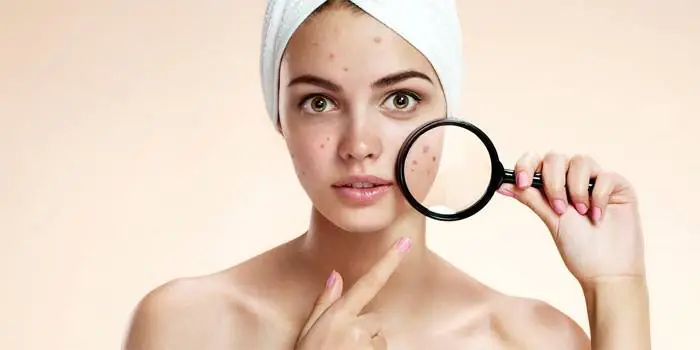
Problems with facial skin, manifested in the form of subcutaneous acne, often indicate hormonal imbalances in the body:
- If small bumps appear on the face that do not go away for a long time, this may be a consequence of developing endocrine pathologies or temporary hormonal imbalance due to natural causes (adolescence, pregnancy).
- In women, white pimples on the face can occur due to ovarian dysfunction caused by polycystic disease. In this case, they are localized on the chin and on the lower cheeks.
- In people with oily or thick skin, internal acne on the face appears due to excessive sebum production and can be located anywhere - on the forehead, nose, cheekbones, chin.
- Painful lumps on the lips that initially look like pimples may be a sign of herpes.
On the back
The appearance of subcutaneous lesions on the back can also be a consequence of sudden hormonal changes, but this phenomenon is often observed in athletes or people leading an active lifestyle. During physical activity, the back constantly sweats, and this contributes to the contamination of the sebaceous ducts and the accumulation of sebum in them, leading to the development of the inflammatory process and the appearance of acne. Find out how to remove acne on a woman's back.
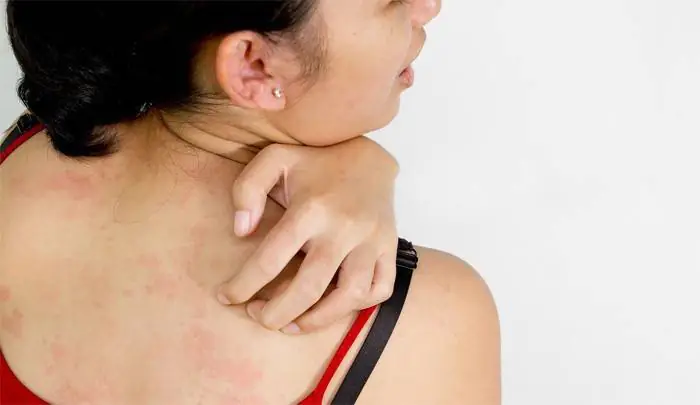
On the neck
Rashes on the neck, located in the deep layers of the epidermis, rarely occur, since the skin in this part of the body is thin. If such pimples appear in this area, it is recommended to undergo a comprehensive medical examination, since they may be associated with diseases of the internal organs or the beginning of the development of pathological processes in the body.
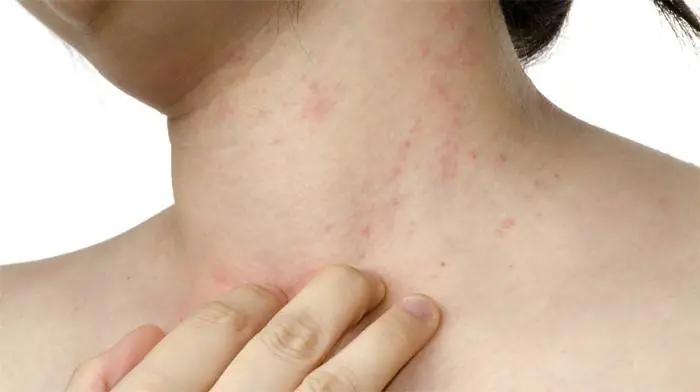
On hands
The appearance of subcutaneous rashes on the hands may indicate endocrine disorders, allergies, and hereditary diseases. If acne appears below the elbow or in the area of the hands, this should be especially alarming, because in these areas there are fewer sebaceous glands and the appearance of skin formations on them can indicate serious pathologies and malfunctions of the body.

On the labia
Subcutaneous formations in the genital area in many cases occur due to hypothermia of the body. They may appear after a cold, swimming in cold water or improper hardening. Other possible causes are microtraumas that occur during hair removal in the bikini area, as well as wearing synthetic underwear, which irritates the skin and causes it to overheat.
Subcutaneous bumps all over the body
If subcutaneous rashes are located throughout the body, this may be a manifestation of a genetic disease - hereditary lipomatosis. With this disease, bumps can appear on any part of the body - neck, arms, legs, stomach, back. This disorder requires careful examination and long-term complex therapy, and sometimes surgical intervention.
How to get rid of internal pimple
If there are a lot of subcutaneous formations and they do not go away for a long time, it is unlikely that you will be able to get rid of them on your own. In such cases, consultation with a dermatologist and special therapy are necessary. The same applies to such an unpleasant manifestation as acne on the face located deep under the skin, the treatment of which must be carried out under the supervision of a specialist.
However, if the pimple is single and has appeared recently, you can try to remove it without seeking medical help by using available pharmacy and home remedies. How to remove the subcutaneous tissue? Such pimples “mature” for a long time, over several weeks, so attempts to squeeze them out will be unsuccessful. How to treat the skin to speed up this process and prevent complications from developing?
Ointment
An excellent remedy for combating subcutaneous skin are Vishnevsky ointment, Levomekol, and zinc ointment. How to pull out a pimple using these drugs? Ointments should be applied to the affected areas at least 2 times a day. In addition, compresses made from ichthyol ointment have a good effect, drawing the contents of the subcutaneous tissue out. It is recommended to apply them at night.
Cream for subcutaneous acne
When treating subcutaneous rashes, creams with an antibacterial and healing effect are helpful, allowing you to quickly stop the inflammatory process and accelerate tissue regeneration in the affected area. The most effective products in this category, recommended for the fight against subcutaneous skin, are the creams “Baziron”, “Differin”, “Skinoren”, “Klenzit-S”.
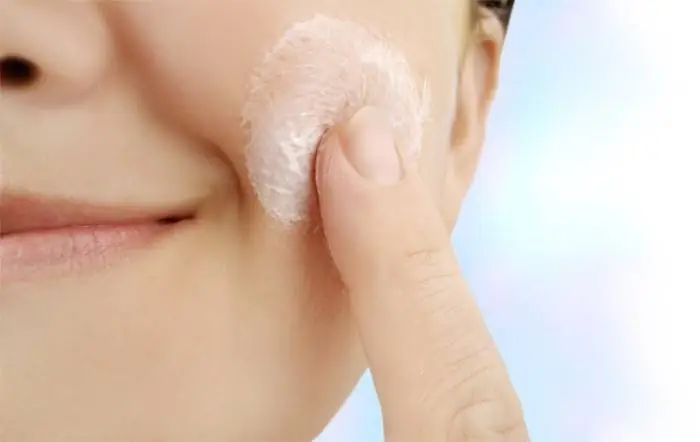
Treatment with folk remedies
Simple folk recipes that are available for use at home will help eliminate subcutaneous formations:
- Aloe compress. It helps well to get rid of such an unpleasant phenomenon as a long-lasting purulent pimple that cannot burst on its own. Cut an aloe leaf, apply it to the site of inflammation and secure with a bandage. It is most convenient to apply the compress at night.
- Tea tree oil. Apply it to your pimples every 3-4 hours for a few days until you notice improvement.
- Mask of oil and garlic. Lubricate the problem area with vegetable oil, and then precisely apply chopped garlic to the area of inflammation and place gauze soaked in hot water over it. Leave on for 20 minutes and rinse off.
How to squeeze a pimple
When deciding to squeeze out a pimple located deep under the skin, it is very important to remember the high risk of infection, even wider spread of rashes or scarring on the skin. A fully mature pimple can be squeezed out after first disinfecting your hands and treating the wound with an antibacterial solution. However, the removal of multiple formations must be entrusted to a dermatologist or cosmetologist.
Video: how to cure an internal pimple
Once and for all, special video materials will help you deal with the problem of subcutaneous rashes, in which this topic is covered in as much detail as possible. Experts talk about the main reasons for the appearance of such formations, provide photos of common types of rashes, explain how to deal with them and how to properly remove a pimple located in the deep layers of the epidermis.



